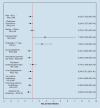[Analysis of risk factors for dropping out of residency in orthopedics and trauma surgery]
- PMID: 36357588
- PMCID: PMC10520118
- DOI: 10.1007/s00113-022-01249-x
[Analysis of risk factors for dropping out of residency in orthopedics and trauma surgery]
Abstract
Background: Currently, there are no data available on dropouts from residency programs and changes of clinic in orthopedics and trauma surgery (O&T). The aim of the study is to identify personal and structural risk factors leading to dropout or switching of postgraduate training in O&T in order to present solution strategies.
Methods: A nationwide anonymous online survey was conducted among residents in O&T in summer 2020. Official mail addresses were identified via the Traumanetzwerk© of the DGU and the German Hospital Federation (n = 2090). A questionnaire (51 questions) was administered using SurveyMonkey (San Mateo, CA, USA). All residents who worked in O&T for at least 1 month in the 6 years prior to the start of the survey (from 07/2014) were eligible to participate. A binary logistic regression was calculated to identify the risk factors. The significance level was p = 0.05.
Results: Of the 221 respondents, 37% switched hospital and 5% dropped out altogether. The regression revealed 3 significant risk factors for switching hospitals. Living in a partnership (p = 0.029, RR: 2.823) and less than 2 days of shadowing before the start of residency (p = 0.002, RR: 2.4) increased the risk of switching. Operating room (OR) allocation of residents according to the training plan/status (p = 0.028, RR: 0.48) reduces the risk of switching. Significant risk factors for leaving postgraduate training could not be determined (insufficient number of cases, n = 11).
Discussion: Switching the hospital and residency dropouts in O&T are a relevant problem (42%). Gender has no significant influence. Tools such as longer job shadowing, as well as OR allocation according to the training plan/status can minimize the risk of switching.
Zusammenfassung: HINTERGRUND: Aktuell liegen keine Daten zu Weiterbildungsabbrüchen und Klinikwechseln im Fach Orthopädie und Unfallchirurgie (O&U) vor. Ziele der Studie sind die Identifikation von persönlichen und strukturellen Risikofaktoren, die zum Abbruch/Wechsel der Weiterbildung in O&U führen, sowie Lösungsstrategien vorzustellen.
Methodik: Im Sommer 2020 wurde eine deutschlandweite, anonyme Onlinebefragung unter den Weiterbildungsassistenten*innen (WA) in O&U durchgeführt. Dienstliche Mailadressen wurden über das Traumanetzwerk© der DGU und die Deutsche Krankenhausgesellschaft identifiziert (n = 2090). Ein Fragebogen (51 Fragen) wurde mit SurveyMonkey Inc. (San Mateo, California, USA) erstellt. Teilnahmeberechtigt waren alle WA, die in den 6 Jahren vor Umfragebeginn (ab Juli 2014) für mind. einen Monat im Fach O&U tätig waren. Zur Identifikation der Risikofaktoren wurde eine binär logistische Regression berechnet. Das Signifikanzniveau lag bei p = 0,05.
Ergebnisse: Von den 221 Befragten wechselten 37 % die Weiterbildungseinrichtung, und 5 % brachen die Weiterbildung in O&U vorzeitig ab. Die Regression ergab 3 signifikante Risikofaktoren, die Klinik zu wechseln. Das Leben in einer Partnerschaft (p = 0,029, RR: 2,823) und weniger als 2 Tage Hospitationen vor Weiterbildungsbeginn (p = 0,002, RR: 2,4) erhöhen das Risiko für Wechsel. Eine Einteilung der WA für Operationen gemäß dem Weiterbildungsplan/-stand (p = 0,028, RR: 0,48) senkt das Risiko für Wechsel. Signifikante Risikofaktoren für das Ausscheiden aus der Weiterbildung konnten nicht ermittelt werden (zu geringe Fallzahl, n = 11).
Diskussion: Weiterbildungswechsel und -abbrüche in der O&U sind ein relevantes Problem (42 %). Das Geschlecht hat keinen signifikanten Einfluss. Maßnahmen wie längere Hospitationen sowie Op.-Einteilung entsprechend dem Weiterbildungsplan/-stand können das Wechselrisiko minimieren.
Keywords: Education; Entrustable professional activities (EPA); Gender Equity; Survey and Questionnaires; Work-Life Balance.
© 2022. The Author(s).
Similar articles
-
Acute Workplace Hazards in Orthopedic Surgery: Resident Survey Regarding Splash and Workplace Violence Events.J Surg Educ. 2020 Nov-Dec;77(6):1638-1645. doi: 10.1016/j.jsurg.2020.05.007. Epub 2020 Jun 3. J Surg Educ. 2020. PMID: 32505670
-
Reasons for resident resignations from Orthopedic Residency Programs in Turkey: A cross-sectional survey from residents' perspectives.Acta Orthop Traumatol Turc. 2022 May;56(3):222-227. doi: 10.5152/j.aott.2022.21384. Acta Orthop Traumatol Turc. 2022. PMID: 35703512 Free PMC article. Review.
-
Burnout syndrome in orthopaedic and trauma surgery residents in France: A nationwide survey.Orthop Traumatol Surg Res. 2018 Dec;104(8):1291-1295. doi: 10.1016/j.otsr.2018.08.016. Epub 2018 Oct 17. Orthop Traumatol Surg Res. 2018. PMID: 30341030
-
Insight into the changing patterns in clinical and academic activities of the orthopedic residents during COVID-19 pandemic: a cross-sectional survey.Knee Surg Sports Traumatol Arthrosc. 2020 Oct;28(10):3087-3093. doi: 10.1007/s00167-020-06274-0. Epub 2020 Sep 14. Knee Surg Sports Traumatol Arthrosc. 2020. PMID: 32926255 Free PMC article.
-
[Orthopedics and trauma surgery-Decathlon of medicine : Is a full education possible during resident education?].Unfallchirurgie (Heidelb). 2023 Apr;126(4):281-284. doi: 10.1007/s00113-022-01271-z. Epub 2022 Dec 19. Unfallchirurgie (Heidelb). 2023. PMID: 36534362 Review. German.
References
-
- Coupland D. Generation X: Geschichten für eine immer schneller werdende Kultur. 13. München: Goldmann; 1995.
-
- EU Parlament, EU Rat RICHTLINIE 2003/88/EG DES EUROPÄISCHEN PARLAMENTS UND DES RATES vom 4. November 2003 über bestimmte Aspekte der Arbeitszeitgestaltung. https://eur-lex.europa.eu/legal-content/DE/TXT/PDF/?uri=CELEX:32003L0088. Zugegriffen: 12. Jun. 2022
-
- Urteil des Gerichtshofs (Große Kammer) vom 14. Mai 2019. ECLI:EU:C:2019:402. (2019, May 14). Retrieved from https://eur-lex.europa.eu/legal-content/DE/TXT/?uri=CELEX:62018CJ0055
Publication types
MeSH terms
LinkOut - more resources
Full Text Sources
Research Materials







